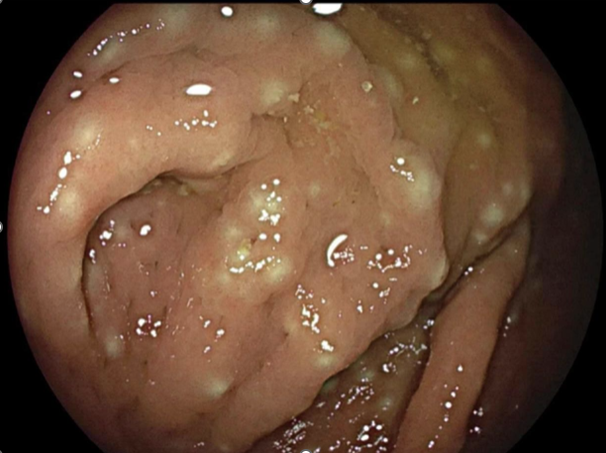Sunday Poster Session
Category: Colon
P0323 - Strongyloides Colitis: An Incidental Finding on a Screening Colonoscopy
Sunday, October 26, 2025
3:30 PM - 7:00 PM PDT
Location: Exhibit Hall
- RD
Ricardo David Espinosa, MD
Ochsner Health Clinic Foundation
New Orleans, LA
Presenting Author(s)
Ricardo David Espinosa, MD, Jordan Boudreaux, MD, Paul Gomez, MD
Ochsner Health Clinic Foundation, New Orleans, LA
Introduction: Strongyloides colitis is a rare entity that is commonly asymptomatic but can present with vague GI symptoms. Infection can persist for decades unless treated, and can lead to severe disseminated disease in immunocompromised patients. Endoscopic findings described in the literature range from yellowish to white nodules and loss of vascular pattern to skip inflammation mimicking Inflammatory Bowel Disease. We present a case of asymptomatic strongyloidiasis colitis incidentally found on a screening colonoscopy.
Case Description/
Methods: A 56-year-old Honduran male with a past medical history of hypertension and diabetes mellitus type II presented for a screening colonoscopy. Patient was asymptomatic and had no gastrointestinal or abdominal symptoms. Vital signs were within normal limits, and the physical exam was unremarkable. Patient is a painter, and travels to Honduras once every 2 years where he describes walking barefoot on the beach. Screening colonoscopy showed punctate white plaques at the hepatic flexure, in the ascending colon, and in the cecum. Biopsies demonstrated colonic eosinophilia. Subsequent visits to the patient's primary care physician revealed absolute and relative peripheral eosinophilia of 2.0 K/uL (23%). Review of previous peripheral eosinophil counts revealed similar values in the previous three years. Stool Strongyloidiasis Ab IgG was then checked and was positive. Three samples for stool ova and parasites were tested which were negative. The patient was treated with a 2 day course of ivermectin 200 mcg/kg to treat strongyloides.
Discussion: In this case, strongyloides colitis was incidentally diagnosed in an asymptomatic patient on a screening colonoscopy. Colonic biopsies demonstrated eosinophilia. Notably, the patient was from an endemic area and had chronic peripheral eosinophilia, which prompted serologic testing and diagnosis of strongyloides infection. This case demonstrates peripheral eosinophilia as a useful clue in diagnosing strongyloides infection, especially in those from an endemic region.

Figure: White nodules seen on colonoscopy.
Disclosures:
Ricardo David Espinosa indicated no relevant financial relationships.
Jordan Boudreaux indicated no relevant financial relationships.
Paul Gomez indicated no relevant financial relationships.
Ricardo David Espinosa, MD, Jordan Boudreaux, MD, Paul Gomez, MD. P0323 - <i>Strongyloides</i> Colitis: An Incidental Finding on a Screening Colonoscopy, ACG 2025 Annual Scientific Meeting Abstracts. Phoenix, AZ: American College of Gastroenterology.
Ochsner Health Clinic Foundation, New Orleans, LA
Introduction: Strongyloides colitis is a rare entity that is commonly asymptomatic but can present with vague GI symptoms. Infection can persist for decades unless treated, and can lead to severe disseminated disease in immunocompromised patients. Endoscopic findings described in the literature range from yellowish to white nodules and loss of vascular pattern to skip inflammation mimicking Inflammatory Bowel Disease. We present a case of asymptomatic strongyloidiasis colitis incidentally found on a screening colonoscopy.
Case Description/
Methods: A 56-year-old Honduran male with a past medical history of hypertension and diabetes mellitus type II presented for a screening colonoscopy. Patient was asymptomatic and had no gastrointestinal or abdominal symptoms. Vital signs were within normal limits, and the physical exam was unremarkable. Patient is a painter, and travels to Honduras once every 2 years where he describes walking barefoot on the beach. Screening colonoscopy showed punctate white plaques at the hepatic flexure, in the ascending colon, and in the cecum. Biopsies demonstrated colonic eosinophilia. Subsequent visits to the patient's primary care physician revealed absolute and relative peripheral eosinophilia of 2.0 K/uL (23%). Review of previous peripheral eosinophil counts revealed similar values in the previous three years. Stool Strongyloidiasis Ab IgG was then checked and was positive. Three samples for stool ova and parasites were tested which were negative. The patient was treated with a 2 day course of ivermectin 200 mcg/kg to treat strongyloides.
Discussion: In this case, strongyloides colitis was incidentally diagnosed in an asymptomatic patient on a screening colonoscopy. Colonic biopsies demonstrated eosinophilia. Notably, the patient was from an endemic area and had chronic peripheral eosinophilia, which prompted serologic testing and diagnosis of strongyloides infection. This case demonstrates peripheral eosinophilia as a useful clue in diagnosing strongyloides infection, especially in those from an endemic region.

Figure: White nodules seen on colonoscopy.
Disclosures:
Ricardo David Espinosa indicated no relevant financial relationships.
Jordan Boudreaux indicated no relevant financial relationships.
Paul Gomez indicated no relevant financial relationships.
Ricardo David Espinosa, MD, Jordan Boudreaux, MD, Paul Gomez, MD. P0323 - <i>Strongyloides</i> Colitis: An Incidental Finding on a Screening Colonoscopy, ACG 2025 Annual Scientific Meeting Abstracts. Phoenix, AZ: American College of Gastroenterology.
